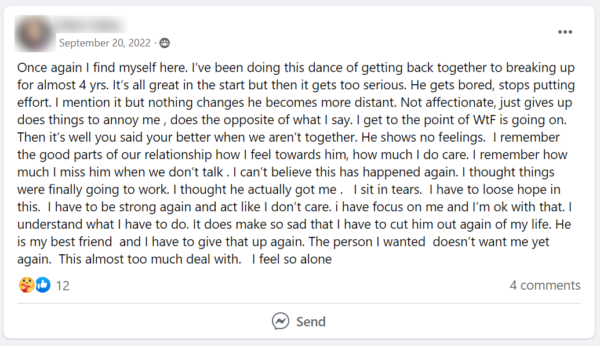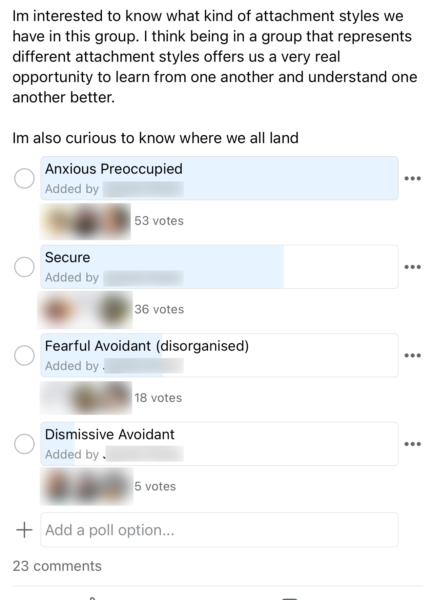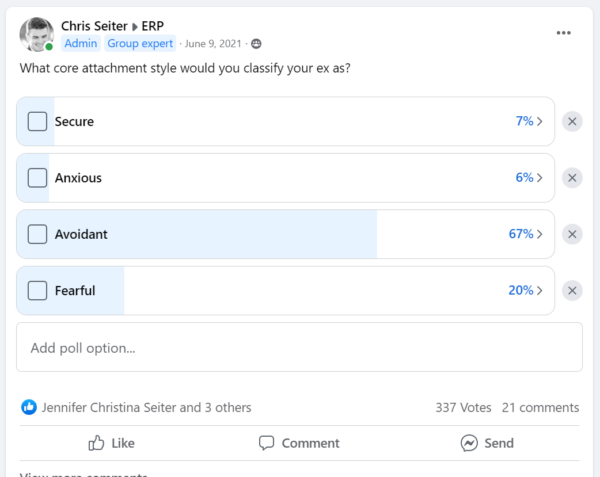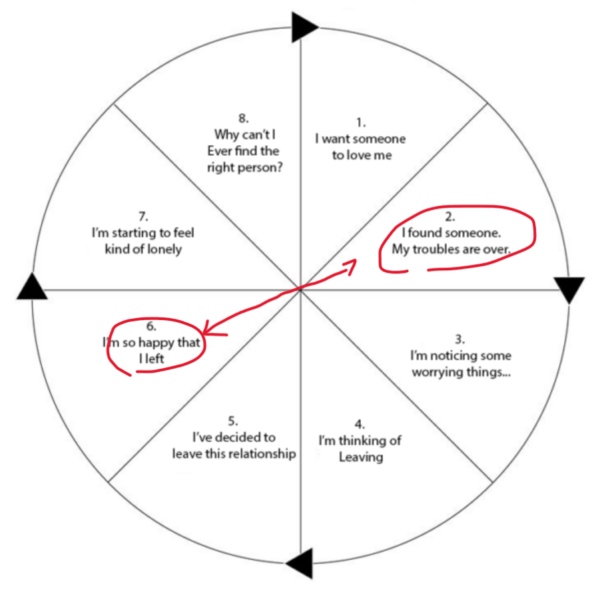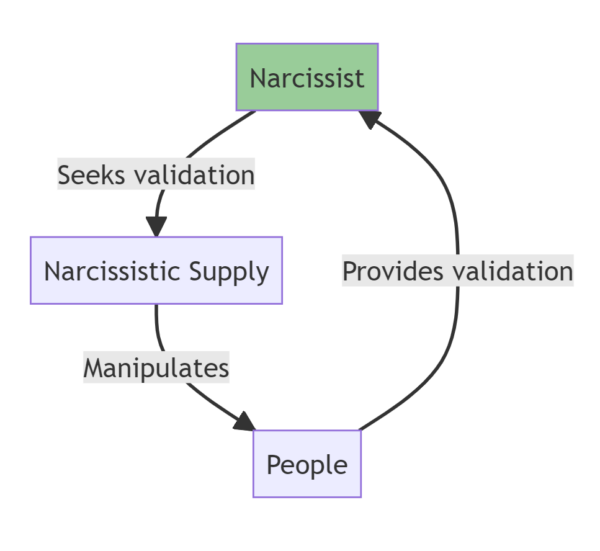There’s this new idea out there called “relationships cycling,” which essentially describes on-again, off-again relationships, which for us is a tale as old as time.
As you can see here,
You know, we’ve had a lot of individuals in our community suffer from these type of situations. But what I’d really like to talk about today is if it’s toxic to be in one of these relationships.
There’s a lot to explore here, and I guess I think I’d first like to start by figuring out:
Why we get caught in these patterns
Then actually answering if it’s toxic
Exploring the stigma associated with getting back together with an ex
And explaining the true beauty of the no-contact rule.
Alright, enough chit chat.
So, why do we get caught in these patterns?

What Are Your Chances of Getting Your Ex Boyfriend Back?
Take the quizWhy We Get Caught In The On Again/Off Again Pattern?
Well, there’s a lot of different reasons we can get caught in these patterns, but I think chief among them is the anxious and avoidant pairing.
A couple of months ago, I stumbled across this research that was looking at the length of relationship time together based on attachment styles.
- So, they found that, as you would assume, someone who has a secure attachment style being partnered up with someone who has another secure attachment style is going to be the most successful, long-lasting relationship.
- But the second most successful pairing, even though it’s pretty unsuccessful, is having an anxious and an avoidant pair together.
That’s because no one will really leave.
The anxious person is afraid of being abandoned, and the avoidant person is too afraid to break up with them.
So, essentially, they just stay together even though both parties are making one another miserable. Through research of our clients, we’ve found that this is without a doubt the most common pairing.
Most of our clients tend to have anxious attachment styles,
While most of their exes tend to have dismissive avoidant attachment styles,
The thing you need to understand about this pairing is that it really revolves around the core wounds.
The anxious individual is going to have a core wound where they’re terrified of being abandoned, and the avoidant pairing is going to have a core wound where they actually want their independence back.
So, what tends to happen in these relationships is the anxious person tends to set the avoidant person off with their constant need for reassurance and seeking validation.

What Are Your Chances of Getting Your Ex Boyfriend Back?
Take the quizThe avoidant will initially avoid any kind of breakup, but ultimately it just becomes too much for them, and they end up breaking up with the anxious person.
Where that becomes particularly difficult is you can often see these pairings get caught in this on-again, off-again relationship.
The anxious person, when they’re inevitably broken up with by the avoidant person, will stop at nothing to try to get the avoidant person back. Now, the avoidant person doesn’t necessarily want that; they want to be left alone.
So, when the anxious people are able to leave their ex alone for a little bit of time, the avoidant can start to see that anxious person as the phantom ex, which makes the avoidant want to come back.
You get this “ring around the rosy” type effect where it’s on again, off again. Both parties try the relationship again, either trying to recapture or falling victim to their insecure attachment styles, and this is how you often get these on-again, off-again patterns.
Let’s Look At Fear Of Abandonment A Bit Closer
But I actually think the most common reason for why we get caught in these patterns is that you’re often feeling too afraid to leave, and usually, that’s because of abandonment.
I had the pleasure, just yesterday, of interviewing the “Crappy Childhood Fairy.”
If you’re not familiar, the “Crappy Childhood Fairy” is a woman by the name of Anna Runkle. She runs a wildly successful YouTube channel. What I think makes her so interesting is that she’s not a doctor or therapist. She’s just someone who grew up with an incredibly rough family affected by addiction, alcoholism, and other issues. This background gave her CPTSD (complex post-traumatic stress disorder).
We talked about this, and she brought up a really interesting point about the fear of abandonment. My argument is that one of the reasons we get caught in these on-again, off-again relationships is that we’re too afraid of the unknown, too afraid of being abandoned.
Anna made a fascinating point as she discussed her own life and why she would get trapped in these relationships but be too afraid to stand up for herself or leave. Here’s an exact quote from her:
“But this happened again and again, and it starts to explain a lot of the stuff that I struggled with later, which is an extremely anxious attachment with severe abandonment wounds. What Pete Walker talks about or calls ‘abandonment melange’ which is kind of like a special, intense emotional cocktail that not everybody gets. When abandonment occurs, when the end of a relationship happens, even thinking about ending a relationship with somebody I couldn’t stand would set me off, and then I wouldn’t do it. The attachment with insecure attachment drives people who have that childhood trauma. It’s a very common trait to rush into relationships, sleep together quickly, experience that bonding, and then, just a couple of days later, think, ‘Oh my God, what have I done? I don’t even like this person I just slept with.’ But the abandonment wound is there to say, ‘Hey, don’t leave, because if you do, you’ll face the worst depression you’ve ever known.’ So people are held hostage by these emotions, driven by this neurological dysregulation.”
I think this is poignant because it delves into the insecure attachment style issue we observe.
We see many people struggle with anxiety, and a significant concern for them is this fear of abandonment.
This fear prevents them from moving on to the next relationship and believing they deserve better, causing them to remain in on-again, off-again cycles where nothing changes.
Let’s Be Honest About Codependency
So, that’s one element.
But if you buy into the idea that a large portion of the clientele we are studying has an anxious attachment style, and they exhibit fearful avoidance or have a fear of abandonment, it’s not too much of a stretch to believe that one of the reasons you see this on-again, off-again pattern happening so frequently is because of codependency.
One thing we know for certain is that codependency and anxiety often go hand in hand.
In many of the anxious and avoidant pairings, the fear of abandonment leads to very codependent-type relationships.
Probably the best way to describe a codependent relationship is by saying that you enter the relationship thinking you need someone else to make you whole. Instead of joining the relationship as a complete individual, you approach it believing in the concept of a soulmate.
This is actually something Anna Runkle and I discussed.
She mentioned her frustration when people talk about “twin flames.” I try to avoid making overly controversial statements, but I do want to say that while the concept of twin flames or the idea that there’s a predestined soulmate for everyone is endearing in theory, it essentially promotes codependency.
It implies that you are not complete until you find this “other half,” which can be very detrimental for those with an anxious attachment style.

What Are Your Chances of Getting Your Ex Boyfriend Back?
Take the quizMuch of the work we do at Ex Boyfriend Recovery focuses on transforming an insecure attachment style into a more secure one.
If you harbor beliefs that you’re not complete without a particular person, it can often lead you into these on-again, off-again situations that lead to significant unhappiness.
But we still haven’t addressed the primary question this entire discussion revolves around: Is it toxic to be in one of these on-again, off-again relationships?
So, Is It Toxic?
I don’t think there’s a simple yes or no answer to this, if I’m being completely honest.
Most people don’t enter relationship cycling seeking out toxicity, but sometimes the toxic elements are present.
So, what are the toxic elements of on-again, off-again relationships?
- Honeymoon Chasing
- Narcissist Supply
Let’s take a beat and talk about both.
Honeymoon Chasing
Well, probably the most common one is the idea of “honeymoon chasing.”
We actually see this phenomenon often with avoidants and fearful avoidants.
In previous articles, I’ve discussed how one of the unfortunate things I’ve noticed about exes is their tendency to cycle from one honeymoon period to another. I’m going to include a graphic of my “avoidant death wheel” because I believe it illustrates this concept perfectly.
If you examine the graphic, you’ll notice I have highlighted two areas. These areas represent the stages where an avoidant feels like they’re in a honeymoon phase. There’s the initial honeymoon phase when you start a relationship, but the avoidant experiences a second honeymoon phase.
Their core wound centers around a need for independence.
So, the moment they end a relationship and regain their independence, they feel elated, experiencing what I call “separation elation.”
They then go through another honeymoon phase. However, the troubling aspect I’ve observed in on-again, off-again relationships is that often one partner is genuinely invested, while the other is merely chasing these honeymoon highs.
They move from one relationship to the next, seeking these euphoric phases. But each subsequent honeymoon period diminishes in intensity. This pattern can be toxic and is eerily similar to behaviors exhibited by narcissists.
Narcissist Supply
Now, while true narcissism is rare, many individuals display narcissistic tendencies. A significant trait to watch for, which can undoubtedly be toxic, is the concept of “narcissistic supply.” I’ve discussed narcissists extensively on Ex-Boyfriend Recovery.
One term I’ve coined to describe their behavior is the “narcissistic Rolodex” or a “supply Rolodex.”
For those unfamiliar with how narcissists operate, they thrive on admiration and require a steady supply of it. They maintain a mental “Rolodex” of people they can turn to for various forms of supply.
Some people provide physical benefits, while others offer emotional ones, listening to the narcissist’s problems and providing solutions. Still, others might serve as casual conversation partners. However, narcissists don’t view these individuals as people but rather as sources to satiate their needs before moving on.
If you find yourself in a relationship with such an individual, it will undoubtedly be toxic. However, as I mentioned earlier, most people don’t enter on-again, off-again relationships with the intent of fostering toxicity.

What Are Your Chances of Getting Your Ex Boyfriend Back?
Take the quizThey genuinely hope for a better outcome the next time around. Yet, it’s also worth noting that there’s a significant stigma associated with rekindling relationships.
Exploring The Stigma Associated With Getting Back Together With An Ex
You know, I remember when I first started my podcast, my wife and I began searching for potential guests.
With podcasts, there’s an inherent gamesmanship. It’s a mutual reciprocity thing – “I’ll scratch your back if you scratch mine.”
Typically, new podcasts face a disadvantage as they lack substantial listenership. So, many desired guests may decline invitations due to the limited exposure they’d receive.
Some of my experiences might be attributed to that. I distinctly recall approaching various individuals who I believed would be excellent guests. Initially, they’d express interest, but upon discovering the nature of our site, which aids people in reconciling, their demeanor would shift
. I had one particularly memorable instance where an individual, whom I held in high regard, responded with a dismissive attitude, as if to say, “I don’t associate with your kind.”
This response highlights the stigma attached to the idea of reuniting with an ex.
Often, friends and family may discourage such endeavors. Many feel embarrassed to admit they’re attempting to win an ex back.
Ironically, while trying to salvage a romantic relationship is viewed skeptically, making efforts to save a marriage is championed, even though the dynamics are fundamentally similar, barring situations involving abuse.
Given this backdrop, is pursuing a former relationship toxic?
Not necessarily. But I’ve outlined signs to determine potential toxicity. Regardless of the circumstances, our advice post-breakup is consistent: initiate the no-contact rule. This rule, which involves consciously avoiding any interactions with your ex, is not just about creating distance.
Our philosophy is: the best way to get your ex back is to genuinely move on from them.
The Beauty Of No Contact
The no-contact period is an opportunity to outgrow past attachments.
This “soft reset” is especially beneficial for those with anxious attachment styles. Anxiety can lead to heightened levels of cortisol, a stress hormone.
The no-contact rule aims to lower these cortisol levels, allowing individuals to make decisions based on logic rather than emotion. Often, impulsive reunions occur in emotionally charged moments.
Especially for those who’ve experienced multiple relationship cycles, it’s crucial to approach any reconciliation with caution to avoid falling into a potentially toxic pattern.
